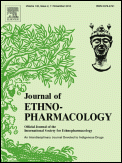
Ethnobotany is the study of a region's plants and their practical uses through the traditional knowledge of a local culture and people. An ethnobotanist thus strives to document the local customs involving the practical uses of local flora for many aspects of life, such as plants as medicines, foods, intoxicants and clothing. Richard Evans Schultes, often referred to as the "father of ethnobotany", explained the discipline in this way:
Ethnobotany simply means investigating plants used by primitive societies in various parts of the world.

D-norpseudoephedrine, also known as cathine and (+)-norpseudoephedrine, is a psychoactive drug of the phenethylamine and amphetamine chemical classes which acts as a stimulant. Along with cathinone, it is found naturally in Catha edulis (khat), and contributes to its overall effects. It has approximately 7-10% the potency of amphetamine.

Passiflora incarnata, commonly known as maypop, purple passionflower, true passionflower, wild apricot, and wild passion vine, is a fast-growing perennial vine with climbing or trailing stems. A member of the passionflower genus Passiflora, the maypop has large, intricate flowers with prominent styles and stamens. One of the hardiest species of passionflower, it is both found as a wildflower in the southern United States and in cultivation for its fruit and striking bluish purple blooms.

Subtribe is a taxonomic category ranking which is below the rank of tribe and above genus. The standard suffix for a subtribe is -ina or -inae. The early use of this word is from 19th century. An example of a subtribe is Hyptidinae, a group of flowering plants that contains approximately 400 accepted species distributed in 19 genera.

Lactucopicrin (Intybin) is a bitter substance that has a sedative and analgesic effect, acting on the central nervous system. It is a sesquiterpene lactone, and is a component of lactucarium, derived from the plant Lactuca virosa, as well as being found in some related plants such as Cichorium intybus. It is also found in dandelion coffee.

Kaempferol (3,4′,5,7-tetrahydroxyflavone) is a natural flavonol, a type of flavonoid, found in a variety of plants and plant-derived foods including kale, beans, tea, spinach, and broccoli. Kaempferol is a yellow crystalline solid with a melting point of 276–278 °C (529–532 °F). It is slightly soluble in water and highly soluble in hot ethanol, ethers, and DMSO. Kaempferol is named for 17th-century German naturalist Engelbert Kaempfer.

Mesembrine is an alkaloid present in Sceletium tortuosum (kanna). It has been shown to act as a serotonin reuptake inhibitor (Ki = 1.4 nM), and more recently, has also been found to behave as a weak inhibitor of the enzyme phosphodiesterase 4 (PDE4) (Ki = 7,800 nM). In an in vitro study published in 2015, researchers concluded that "a high-mesembrine Sceletium extract" may exert anti-depressant effects by acting as a monoamine releasing agent." As such, mesembrine likely plays a dominant role in the antidepressant effects of kanna. The levorotatory isomer, (−)-mesembrine, is the natural form.

Mepenzolate is an antimuscarinic.
Nina Lilian Etkin was an anthropologist and biologist. Etkin was noted for her work in medical anthropology, ethnobiology, and ethnopharmacology. She studied the relation between food and health for over thirty years. Her work involved complementary and alternative medicines for prevention and treatment in Hawai‘i; the use of ethnomedicines in Indonesia; and health issues in Nigeria. She won numerous grants and awards from national and international agencies and published several books as well as over 80 professional articles in peer reviewed journals.

Herniaria hirsuta is a species of flowering plant in the family Caryophyllaceae known by the common name hairy rupturewort. It is native to Eurasia and North Africa, and it is known on other continents, including North America, as an introduced species. This is an annual herb with stems up to 20 cm (8 in) long usually growing prostrate along the ground. The small, fuzzy, pale green leaves are up to about a centimeter long and coat the stems. The inflorescences appear in the leaf axils. Each contains three to eight hairy green sepals and no petals. The fruit is a tiny bumpy utricle containing one seed.

Galangin is a flavonol, a type of flavonoid.

Ibogamine is an anti-convulsant, anti-addictive, CNS stimulant alkaloid found in Tabernanthe iboga and Crepe Jasmine. Basic research related to how addiction affects the brain has used this chemical.
Palpu Pushpangadan is a former Director of the Tropical Botanical Garden and Research Institute (TBGRI) in Kerala. He is also a former Director of the National Botanical Research Institute (NBRI), Lucknow and Rajiv Gandhi Centre for Biotechnology, Thiruvananthapuram. He received the Padmashri Award from the Government of India in 2010.

Croton sylvaticus is a tree in the family Euphorbiaceae. It is commonly known as the forest fever-berry. These trees are distributed in forests from the east coast of South Africa to Tropical Africa. It grows 7–13 metres (23–43 ft) in height, occasionally up to 30 metres (100 ft), in moist forests, thickets and forest edges at altitudes of 350–1,800 metres (1,100–5,900 ft).

Bergenin, alias cuscutin, is trihydroxybenzoic acid glycoside. It is the C-glycoside of 4-O-methyl gallic acid. It possesses an O-demethylated derivative called norbergenin. These are chemical compounds and drugs of Ayurveda, commonly known as Paashaanbhed. It shows a potent immunomodulatory effect.

Bakuchiol is a meroterpenoid in the class terpenophenol.

Pulok Kumar Mukherjee is an Indian scientist working as the Director of Institute of Bioresources and Sustainable Development, an autonomous Institute under Department of Biotechnology, Govt. of India, Imphal, Manipur, India; as well as an Associate Editor of the Phytomedicine Plus; Consulting Editor of the Pharmacological Research published by Elsevier. He is the Professor of Pharmaceutical technology at the Jadavpur University and former Director of the School of Natural Product Studies, Jadavpur University, Kolkata, India.
Cannabis is illegal in Mongolia. In 2008, most of the cannabis seized in Mongolia was grown locally, though some was produced in Russia.

Anthurium marmoratum is a species of plant in the genus Anthurium native to western Colombia and Ecuador. It is a member of the section Cardiolonchium, or the velvet-leaved Anthuriums, along with A. papillilaminum, A. regale, A. crystallinum, and others. It is one of many species used by curanderos in South America to treat snakebite.

Ben-Erik van Wyk FAAS is a South African professor of indigenous botany and traditional African medicine at the University of Johannesburg.

















